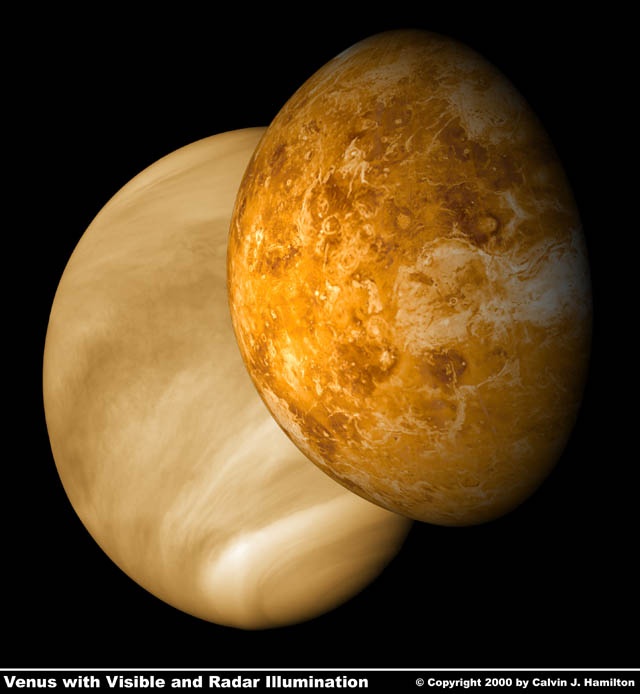Astronomy Picture of the Day
Discover the cosmos! Each day a different image or photograph of our fascinating universe is featured, along with a brief explanation written by a professional astronomer.
Posted on 04/26/2003 9:46:15 PM PDT by petuniasevan
Discover the cosmos! Each day a different image or photograph of our fascinating universe is featured, along with a brief explanation written by a professional astronomer.
Explanation: If you could look at Venus with radar eyes - this is what you might see. This computer reconstruction of the surface of Venus was created from data from the Magellan spacecraft. Magellan orbited Venus and used radar to map our neighboring planet's surface between 1990 and 1994. Magellan found many interesting surface features, including the large circular domes, typically 25-kilometers across, that are depicted above. Volcanism is thought to have created the domes, although the precise mechanism remains unknown. Venus' surface is so hot and hostile that no surface probe has lasted more than a few minutes.
I will be on vacation from June 2nd through June 9th.
If anyone would like to volunteer to post APOD during that time, please FReepmail me.
Otherwise the APOD will not be posted as I will be visiting relatives in California.
Venus has a few similarities to Earth. It's nearly the same size, is a rocky planet, and has an atmosphere. There the similarities end.
Compare the tables below.
| Venus Statistics | |
|---|---|
| Mass (kg) | 4.869e+24 |
| Mass (Earth = 1) | .81476 |
| Equatorial radius (km) | 6,051.8 |
| Equatorial radius (Earth = 1) | .94886 |
| Mean density (gm/cm^3) | 5.25 |
| Mean distance from the Sun (km) | 108,200,000 |
| Mean distance from the Sun (Earth = 1) | 0.7233 |
| Rotational period (days) | -243.0187 |
| Orbital period (days) | 224.701 |
| Mean orbital velocity (km/sec) | 35.02 |
| Orbital eccentricity | 0.0068 |
| Tilt of axis (degrees) | 177.36 |
| Orbital inclination (degrees) | 3.394 |
| Equatorial surface gravity (m/sec^2) | 8.87 |
| Equatorial escape velocity (km/sec) | 10.36 |
| Visual geometric albedo | 0.65 |
| Magnitude (Vo) | -4.4 |
| Mean surface temperature | 482°C |
| Atmospheric pressure (bars) | 92 |
Atmospheric composition
|
96% 3+% |
| Earth Statistics | |
|---|---|
| Mass (kg) | 5.976e+24 |
| Mass (Earth = 1) | 1.0000e+00 |
| Equatorial radius (km) | 6,378.14 |
| Equatorial radius (Earth = 1) | 1.0000e+00 |
| Mean density (gm/cm^3) | 5.515 |
| Mean distance from the Sun (km) | 149,600,000 |
| Mean distance from the Sun (Earth = 1) | 1.0000 |
| Rotational period (days) | 0.99727 |
| Rotational period (hours) | 23.9345 |
| Orbital period (days) | 365.256 |
| Mean orbital velocity (km/sec) | 29.79 |
| Orbital eccentricity | 0.0167 |
| Tilt of axis (degrees) | 23.45 |
| Orbital inclination (degrees) | 0.000 |
| Equatorial escape velocity (km/sec) | 11.18 |
| Equatorial surface gravity (m/sec^2) | 9.78 |
| Visual geometric albedo | 0.37 |
| Mean surface temperature | 15°C |
| Atmospheric pressure (bars) | 1.013 |
Atmospheric composition
|
77% 21% 2% |
This picture shows two different perspectives of Venus. On the left is a mosaic of images acquired by the Mariner 10 spacecraft on February 5, 1974. The image shows the thick cloud coverage that prevents optical observation of the planet's surface. The surface of Venus remained hidden until 1978 when the Pioneer Venus 1 spacecraft arrived and went into orbit about the planet on December 4th. The spacecraft used radar to map planet's surface, revealing a new Venus. Later in August of 1990 the Magellan spacecraft arrived at Venus and began its extensive planetary mapping mission. This mission produced radar images up to 300 meters per pixel in resolution. The right image show a rendering of Venus from the Pioneer Venus and Magellan radar images.

The above image comes from the Solarviews Venus image and movie gallery. Here's the URL for page one of seven:

All the same, Venus is an excellent candidate for terraforming some day. It would need to be moved to an orbit farther from the sun, and it should have a good-sized moon of its own. How to do that and drive real estate agents to a marketing frenzy?
An interesting note; if you look at a picture of the spacecraft, you will notice it is almost all white. You are looking at a multilayer insulation (MLI) of metalized Mylar, Dacron net, and Kapton with an outer layer of white woven quartz. The quartz is the white you see in the pics.
Disclaimer: Opinions posted on Free Republic are those of the individual posters and do not necessarily represent the opinion of Free Republic or its management. All materials posted herein are protected by copyright law and the exemption for fair use of copyrighted works.